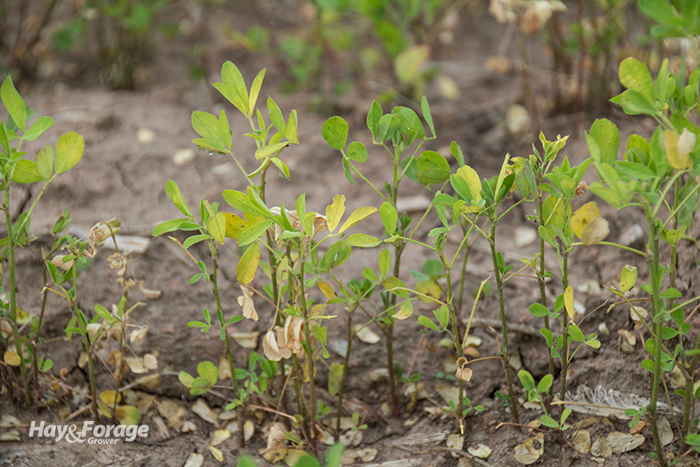Select seed with disease in mind |
| By Amber Friedrichsen, Managing Editor |
|
|
 With a new year comes opportunities for new alfalfa seedings. For those whose list of resolutions includes establishing alfalfa, it is encouraged to secure seed supplies early, and selecting varieties with disease resistance can be essential for a successful spring seeding. Deborah Samac is a research plant pathologist with the USDA Agricultural Research Service in St. Paul, Minn. She discussed alfalfa seedling diseases, as well as those that affect mature plants, during a recent I-29 Moo University webinar. Samac said wet soil is the preferred environment for oomycetes, also known as water molds. These fungus-like organisms have swimming spores that can quickly infect plant roots in saturated conditions, causing damping off diseases like pythium seed rot, phytophthora root rot, and aphanomyces. Spring seedings of alfalfa are more susceptible to wet soil diseases than alfalfa that is seeded in the fall. Even though it may be tempting to push the planting window ahead of other fieldwork, Samac stressed that waiting until soil temperatures warm up to at least 50ºF will help minimize damping off problems. Another way to mitigate seedling diseases is to plant fungicide-treated seed, which Samac said is a relatively standard offer for most seed packages. Research shows a significant improvement in germination among treated alfalfa seed compared to untreated seed. Even so, germination will never be 100%, and alfalfa seed is so small that bundling too many fungicides can dilute the active ingredients of individual treatments. Moreover, Samac said seed treatments only last for about 30 days even though the diseases are perennial. Therefore, she contended the best long-term solution for root rot and damping off is genetic resistance. The research plant pathologist explained that alfalfa seed with high resistance (HR) to a particular disease indicates at least 50% of seed in the bag will be resistant to that disease. With that said, disease pressure varies by region. For example, growers in the West may need to target high resistance to stem nematode resistance, whereas Midwestern growers should seek out seed with high resistance to aphanomyces Race 1 and Race 2. Common occurrences Different aphanomyces races, which are different variants of the pathogen, present a unique challenge to alfalfa. However, aphanomyces is not exclusive to seedlings; it can affect mature alfalfa plants as well. In fact, Samac receives multiple reports a year of stunted, yellow plants that lack lateral roots and root nodules — signs of aphanomyces. Another wet soil disease that can affect older stands is brown root rot. According to Samac, this disease also targets lateral, fibrous alfalfa roots and is characterized by circular lesions along the taproot. Once these lesions appear, secondary bacteria are prone to enter plant roots, which can complicate disease identification. Brown root rot has appeared sporadically across the Northern states, and there are few alfalfa varieties on the market that are resistant to it. Therefore, Samac suggested the best way to combat the disease is by selecting a cultivar with good winter survival. Root lenticles can also appear under saturated soil conditions during the spring, but these white masses of tissue that form along lateral root junctures do not indicate disease. In fact, Samac noted root lenticles are important for gas exchange and may be more prevalent in heavy-textured soils. In addition to visiting the Crop Protection Network to learn more about alfalfa disease symptoms, disease life cycles, and how diseases progress over the growing season, Samac encouraged farmers to consider their options for disease-resistant seed in the latest edition of the National Alfalfa and Forage Alliance’s (NAFA) Alfalfa Variety Ratings. |
